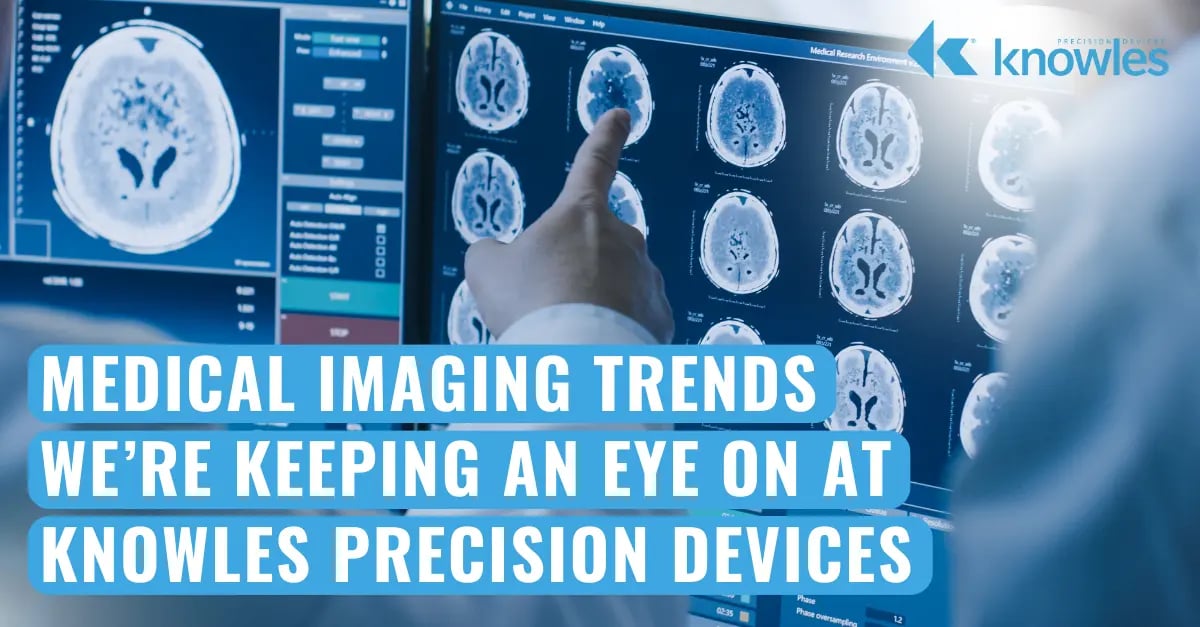In the first installment of our healthcare technology series, we discussed areas where health outcomes are improving as technology shifts closer to patients. Here, we’ll scratch the surface on three trends that are improving medical imaging technologies, and by extension, diagnostics, patient outcomes and access to care. We’ll use magnetic resonance imaging (MRI), which leverages radio frequency (RF) signals, to contextualize these trends.

Medical professionals rely on a variety of medical imaging techniques to non-invasively visualize internal body structures and functions. These techniques are useful for diagnosing diseases and injuries, monitoring treatment performance and surgical planning. Each imaging modality is designed with different clinical use cases in mind (Figure 1).
| Technology | Signal* | Frequency | Applications |
| Ultrasound | Sound | 10's of KHz+ | Blood vessels, muscles, tendons and blood flow |
| MRI | RF Signals | 10's of MHz+ | Soft tissue |
| Endoscopy | Visible and IR | 100's of GHz+ | Gastroscopy, brochoscopy, uretroscopy, neuroscopy |
| OCT | Opthalmology, dermatology, cardiology, oncology | ||
| X-Ray | X-Ray Radiation | 10's of PHz+ | Bones, Soft Tissue |
| CT-Scan | Head, neck, lungs, cardiac, abdominal, bones, ligaments | ||
| PET | Gamma Radiation | 10's of EHz+ | Oncology |
| SPEC | Oncology |
* Signals range from sound waves at 20kHz to Gamma Radiation at Exa-Hertz
Figure 1: Popular imaging modalities and their relevant clinical applications.
Combining Imaging Modalities
Hybrid imaging technologies leverage the strength of a combination of techniques to produce highly detailed views of the body. Medical professionals use these images to diagnose and treat patients more effectively.
For example, PET/MRI scans integrate positron emission tomography (PET) scans and MRI scans. MRI offers detailed images of internal bodily structures and their functions while PET highlights abnormalities using tracers. This combination is particularly helpful in care related to Alzheimer’s disease, epilepsy and brain tumors. Historically, it wasn’t possible to integrate PET and MRI because MRI’s strong magnets interfered with PET’s imaging detectors. Scans were taken separately and merged, which involved complex image processing and potential data loss. According to Stanford Medicine, the PET/MRI combination is more accurate, safer and more convenient than performing separate scans.
Increasing Imaging System Performance
Performance improvements lead to better image quality and more accurate information for diagnostic and treatment purposes. For example, researchers have access to MRI systems with field strength up to 7T now. This performance improvement enhances signal-to-noise ratio (SNR), so imaging results are clearer and more detailed. There’s also a push to make MRI receivers more digital in nature. With higher resolution and higher frequency analog-to-digital converters (ADCs) available, there’s an opportunity to shift the ADC to the RF coil, which can reduce noise and increase SNR when power consumption is managed appropriately. Similar benefits can also be achieved by adding more individual RF coils to the system. Focusing on performance translates to improving elements of patient experience like scan times and cost too.
Designing Imaging Equipment for Portability
By design, some patient assessment and treatment equipment started out in controlled environments for proper function (e.g., MRI suite). Computed tomography (CT) and magnetic resonance imaging (MRI) are great examples. While these imaging techniques are effective for diagnosis, they can be physically demanding for critically ill patients. Technological development is moving these diagnostic services to where patients are.
For traditionally stationary devices like MRI machines, designing for portability requires consideration for factors like size and weight, power, magnetic field strength, cost, image quality and safety. At the components level, selections like high-performance capacitors are important for stable and efficient power generation and signal processing in a smaller, portable footprint.
Questions about how Knowles Precision Devices can support the design and manufacturing of innovative medical imaging equipment? Contact us.

